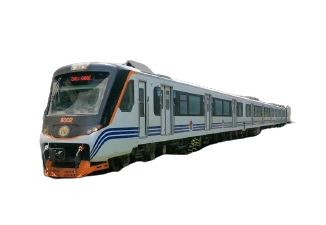The Metrotren was a transport program of the Philippine National Railways and the Department of Transportartions and Communications.
History
The Metrotren, originally called Metrotrak was launched on December 14, 1989 as part of the Metroplex program of the DOTC, which aims to improve the transportation from Metro Manila to surrounding areas, it involves overhauling of locomotives and passenger cars and the rehabilitation of stations from Caloocan to Calamba.
The service continued during the succeeding years although coverage has shrunk followed by the closure of the Meycauayan-Caloocan section and the Carmona Line.
Rolling Stock
The rolling stock used were overhauled and reconditioned motor cars trailers purchased from the Marcos Administration, some motor cars were loco-hauled after being demotorized, loco-hauled services increased followed by the acquistion of additional ten U6B locomotives from General Electric.
- Commuter Motor Car (Self-Propelled / Loco Hauled)
- Commuter Trailer Car
Some Auxilliary Trailers with functional and non-functional aircons and third class cars were converted to regular trailer cars, Motor-Car-Baggage-Power (MCBP) were also used following their withdrawal from Manila-Legazpi Services.
Configuration
- CMC+CTC+CMC
- CTC+CTC+CTC+CMC+U6B / U10B
- CMC+TA+MCBP
Some configurations have a mixed up of demotorized motor cars, trailer cars and auxilliary trailer cars.
Informations
- The name was changed from Metrotrak to Metrotren to avoid confusion with the Metrorail (today's LRT Line 1).
- The Metrotren was formed under the late General Manager Pete Prado.
- The "Balik Pamasahe Pag-nadelay Scheme" returns the fare to the commuters when delay or accidents occured.
- The Metrotren was planned to reach San Fernando, La Union, if not for the eruption of Mt. Pinatubo.
- Although Metrotren focuses on commuter services, long distance services were also applied with the Metrotren Livery.
- Pandacan was not included in the rehabilitation of the stations.
